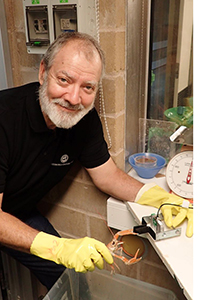
Jeffrey D. Shields
Professor
Email:
jeff@vims.edu
Phone:
(804) 684-7128
Office:
Andrews Hall 426
Section:
Ecosystem Health
Interests:
Parasitic and microbial diseases invertebrates and fishes.
Website:
Crustacean Diseases
Education
- B.S., Ph.D., University of California, Santa Barbara
- M.S., University of California, Berkeley
Research Interests
My expertise is in the etiology and epidemiology of parasitic and microbial diseases of commercially important fish and shellfish. Recently, I have been working on the epidemiology and pathology of microbial and protozoal infections in crustaceans, particularly blue crabs and American lobsters. I've also worked on the etiology of diseases in molluscs, aspects of fish pathogens, and the lack of toxicity in Pfiesteria. Visit my personal website for an up-to-date list of my publications.
- Epidemics of Hematodinium spp., an unusual group of parasitic dinoflagellates, have caused financial losses to the fishermen of the USA and Canada. Recently my group has developed a sentinel technique to study transmission dynamics in the field (Shields et al. 2017, Huchin-Mian et al. 2018. This has opened the door to a better understanding of the life cycle and ecology of this group of pathogens. I've published extensively on this group including documenting mortalities to crab fisheries, elucidating the hematology and host factors in the disease, examining the pathophysiology of infections, and establishing the parasite in culture for additional life cycle studies.
- I have an active interest in understanding how climate change alters the host-parasite relationship in crustaceans and their pathogens. I've published a review showing that as ocean water temperatures increase, so have epizootics of pathogens in important crustacean populations (Shields 2019). I'm interested to see if this is broadly applicable to planktonic crustaceans as well. This work has ties with my work on epizootic shell disease and other diseases in lobsters as well as infectious diseases in hosts infected by Hematodinium and other pathogens.
- Lobster health issues have been emerging over the last twenty years as a result of environmental change and anthropogenic impacts. Recently I've been studying how epizootic shell disease affects American lobsters from Long Island and the Gulf of Maine (Barris et al. 2018; Groner et al. 2018; Reardon et al. 2018). My group as studied the dysbiotic microbiome of the disease, its proliferation, phenological shifts in the disease's ecology, and the first report of the disease in waters off Maine. My group has also discovered that 50% of the lobsters in Long Island Sound are blind and we've been trying to determine the etiology of this idiopathic blindness (e.g., Ochs et al. 2018, Ochs et al. 2020). This has involved developing a non-invasive means to assess animals for blindness as well as a study looking directly at the potential role of manganese in the syndrome.
